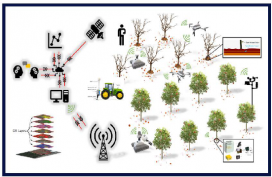Developing an IoT Infrastructure for a Model Orchard
By 2050, the US population is estimated to grow to 400 million and the world population to 9.7 billion. To promote food, energy, and water security for the future, researchers are working to bring the Internet of things (IoT)—physical objects with sensors, processing ability, software, and other technologies—to bear in agricultural processes to advance sustainable, high production. A recent achievement is development of a model orchard to integrate and test IoT technology in a horticultural crop. This research is being performed by a team from the NSF-funded Internet of Things for Precision Agriculture (IoT4Ag) Engineering Research Center (ERC), headquartered at the University of Pennsylvania.
By using sensors to collect data on weather, soil moisture, crop health, and real-time locational asset tracking, farmers can make more informed decisions about how to care for their crops. One of IoT4Ag’s priorities is to develop and deploy a hybrid biophysical model-based and data-driven farm operations decision control system for timely and optimized responses across each stage of the crop lifecycle. The model orchard is being used as a testbed to evaluate different sensors and sensor platform technologies under field conditions. Across the orchard, the research team established internet coverage, installed a sap flow sensor, mounted several weather stations, and acquired different layers of plant variability maps using drone imaging. All data are being stored on a cloud server in real-time and accessible at any time. The ultimate benefit of this project is to show how a tree-specific management strategy can be implemented in a commercial orchard. It can also serve as a testing ground to evaluate the effectiveness and potential of different loT technologies under the actual field condition. Large scale data collection and conducting management decisions based on high-density field data is not possible through traditional methods. The impact of this study is to show growers how loT technology for ag production can be cost-effectively implemented in their operations and help them adopt the suitable technology.
Precision agriculture is a farming management approach that uses digital technologies to enable farmers to make better decisions about where, when, and how much to fertilize, irrigate, and spray pesticides. IoT4Ag’s orchard model is being used to inform data-centric approaches including the capture of spatial/temporal/spectral uncertainty for each stage of the crop lifecycle. Data-centric artificial intelligence (AI) and machine learning (ML) approaches will also be used to inform, refine, and calibrate the model. A key part of this work is to have targeted (smart/wise) sensing to capture data where uncertainty is great or the impact of decisions weighs heavier on financial and environmental outcomes. Better data does not just mean more precise and accurate, but also refers to “data most pertinent” to decisions to be made. Doing this well will require an integration of AI/ML and mechanistic models regarding plants, soils, machinery, and labor.
This effort keeps at the forefront the end goal of improved decision-making (both strategic and tactical) while realistically dealing with many data challenges facing agriculture. Namely, the data in agriculture involves a wide range of spatial/time scales and modalities. The sensor data comes from assorted hardware and software platforms, some commercial and some “research innovations.” The data will not have the same native resolution (i.e., samples will be collected at different locations and time scales) and will include varying spatial, temporal, and measurement uncertainty. One early challenge to be met is to make this data autonomous and interoperable. That interoperability must be with other data as well as with biophysical or simulation models.



